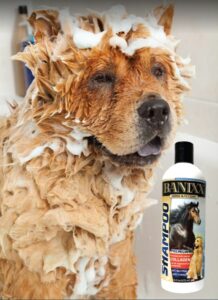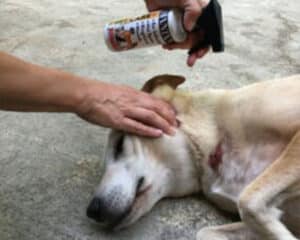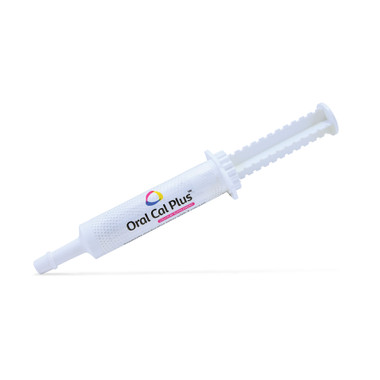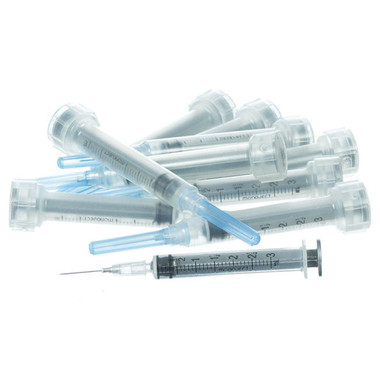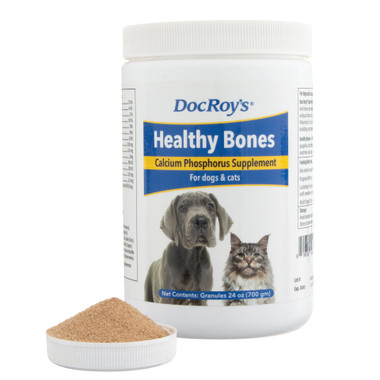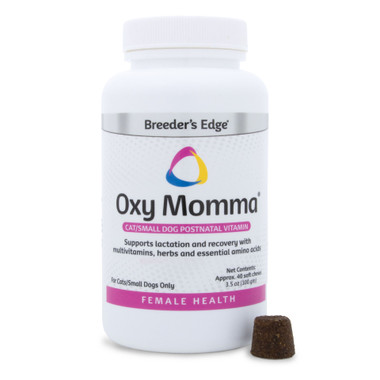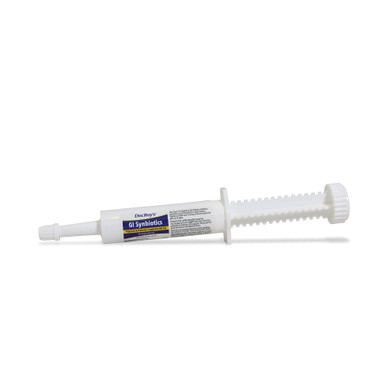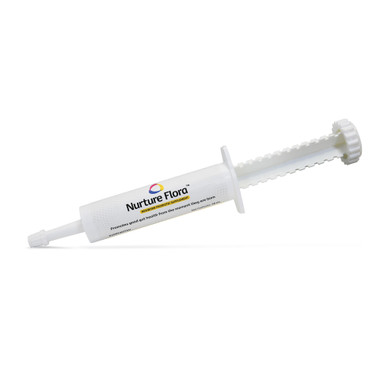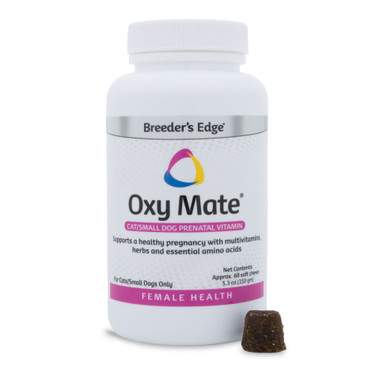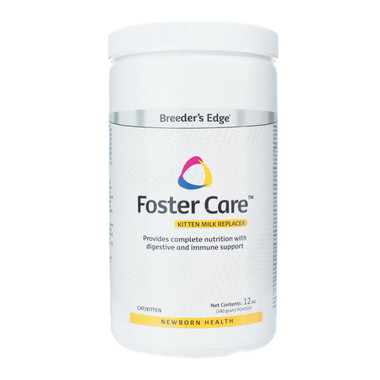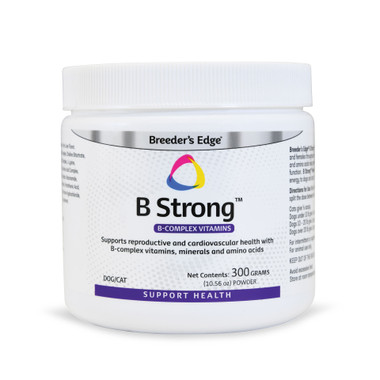How to Take Care of a Short-Haired Dog
Estimated 0 min read
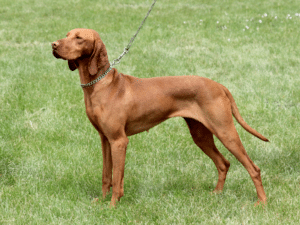
Short haired dog
Those velvety-smooth coats, the way they feel like living suede under your fingers, and that adorable shimmer when the sun hits their fur just right – short-haired dogs are absolutely irresistible.
But beneath that seemingly low-maintenance exterior lies a coat that requires more attention than most pet parents realize.
While these pups might not need regular trips to the groomer for haircuts, understanding the unique needs of their coat type can make the difference between a dull, constantly-shedding companion and a glossy, healthy furry friend.
Understanding Short-Haired Dogs
The absence of a dense undercoat in single-coated varieties means these dogs may need additional protection during colder months, as they lack the natural insulation of double-coated breeds. This biological feature explains why some short-haired dogs benefit from protective clothing during winter months. Contrary to popular belief, short-haired dogs are not hypoallergenic, as allergic reactions typically stem from skin dander rather than the length of fur.
Short-haired breeds experience a unique shedding pattern that differs significantly from their long-haired counterparts. Rather than seasonal heavy shedding, these dogs typically shed continuously throughout the year, releasing dead hair and skin cells called dander. This constant renewal process helps maintain the coat’s protective properties and ensures healthy skin underneath. Some short-haired breeds feature a single coat layer, which impacts their ability to regulate temperature and requires special consideration during extreme weather conditions.
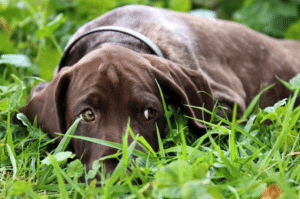
Look at that shiny coat!
Modern short-haired dogs maintain these impressive coat characteristics despite their transition from working animals to beloved family companions. Their coat’s natural ability to repel dirt and resist matting makes them practical pets for active families, though they still require consistent grooming to maintain optimal coat health. Essential grooming tools designed specifically for short-haired coats help maintain these natural protective features while supporting healthy skin and fur growth.
The smooth coat characteristics of short-haired breeds serve multiple biological functions. Their coat acts as a protective barrier against environmental elements while facilitating efficient body temperature regulation through the distribution of natural oils. These oils create a water-resistant layer that helps protect the skin from moisture and environmental irritants while maintaining proper hydration levels. Dead hair and skin cells must be regularly removed to allow this system to function effectively and prevent buildup that could interfere with the coat’s natural protective properties.
A well-equipped grooming arsenal forms the foundation of effective short-haired dog care, enabling owners to maintain their pet’s coat health year-round. Professional groomers and veterinarians emphasize the importance of selecting tools specifically designed for short coats, as these implements work differently than those created for longer-haired breeds. The right combination of grooming tools not only helps remove dead hair and distribute natural oils but also provides an opportunity to monitor your dog’s overall health through regular skin checks.
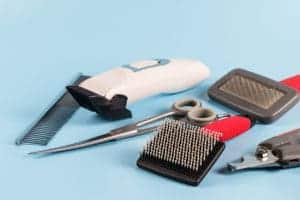
Dog grooming tools
Essential Tools and Products for Grooming a Short-Haired Dog
Daily Grooming Tools
Stiff Bristle Brush
The cornerstone of short-hair grooming lies in a high-quality stiff bristle brush with tightly packed bristles designed to penetrate short coats effectively. These specialized brushes excel at removing dead hair and stimulating natural oil production in your dog’s skin, promoting a healthier and shinier coat.
Rubber Curry Comb
A round rubber curry comb with flexible knobs provides gentle yet effective dead skin removal while simultaneously offering a soothing massage experience for your pet. The rubber material naturally attracts loose hair and helps prevent it from becoming airborne during grooming sessions, making cleanup easier.
Deshedding Tool
During heavy shedding periods, a specialized deshedding brush helps manage the constant year-round shedding typical of short-haired breeds. This tool reaches deeper into the coat to remove loose undercoat without damaging the top layer of fur.
Fine-Toothed Comb
A fine-toothed comb serves as the final step in daily grooming, capturing any remaining loose hair and ensuring thorough coverage of all areas. The narrow spacing between teeth helps detect any skin abnormalities or parasites that might otherwise go unnoticed.
Rubber Grooming Glove
Rubber grooming gloves offer dual functionality by removing loose hair while simultaneously distributing natural oils throughout the coat. The tactile nature of these gloves allows for better control when grooming sensitive areas and helps stimulate blood flow to hair follicles.
Bathing and Moisturizing Products
Gentle Dog Shampoo
Short-haired dogs benefit from specially formulated shampoos that clean effectively without stripping natural oils from their coat. These products should contain natural ingredients that support skin health and promote proper moisture balance.
Moisturizing Conditioner
Light conditioners designed specifically for short coats help maintain proper skin hydration while avoiding heavy residues that might weigh down the fur. Products containing silk proteins and natural moisturizers provide optimal results without causing buildup.
Hypoallergenic Options
Dogs with sensitive skin require fragrance-free, hypoallergenic shampoo formulations that clean gently while avoiding potential irritants. These specialized products help maintain coat health without triggering skin sensitivities.
Eye and Wrinkle Wipes
Specialized cleaning wipes help maintain hygiene in facial folds and around eyes, particularly important for short-haired breeds with wrinkled faces. These gentle wipes remove accumulated debris while helping prevent skin fold dermatitis.
Creating an effective grooming routine requires understanding how each tool and product contributes to your dog’s overall coat health and maintenance. The combination of proper tools and quality products ensures that short-haired dogs receive comprehensive care that addresses both their cosmetic and health needs.
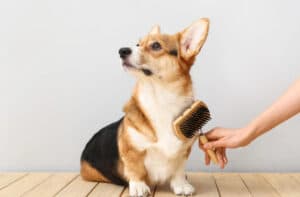
Dog being groomed
Complete Grooming Routine for Short-Haired Dogs
The foundation of a healthy short-haired dog starts with establishing a consistent grooming schedule that addresses daily, weekly, and monthly care needs. Understanding the proper timing and techniques for each grooming task helps prevent common issues while promoting optimal coat health. Professional groomers emphasize that regular maintenance significantly reduces the amount of loose hair in your home while supporting your dog’s natural coat functions.
Daily Maintenance Requirements
Morning Brush Session
A thorough morning brushing with a damp cloth preparation helps control flying hair and maintains optimal coat condition throughout the day. The dampening process keeps loose hair contained while making the brushing process more effective at removing dead skin cells and distributing natural oils.
Targeted Area Inspection
Daily examination of skin folds and creases requires gentle manipulation of the skin to ensure thorough cleaning and inspection of these sensitive areas. Proper inspection techniques include holding skin folds taut while brushing to ensure complete coverage and early detection of any developing skin issues.
Evening Oil Distribution
The final grooming session of the day focuses on using rubber grooming tools in circular motions to stimulate blood flow and distribute natural oils. This process helps maintain proper skin moisture levels while promoting healthy hair follicle function throughout the night.
Weekly Care Protocol
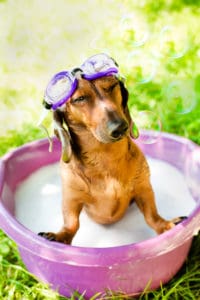
Dog getting a bath
Pre-Bath Assessment
Weekly evaluation determines if bathing is necessary based on activity level, environmental conditions, and overall coat condition. This assessment includes checking for any signs of skin irritation or unusual odors that might indicate the need for specialized cleaning.
Comprehensive Bathing Process
The bathing process begins with thorough brush-out to remove loose hair, followed by ear protection and careful shampooing that avoids sensitive areas. Special attention must be focused on maintaining appropriate water temperature and using gentle massage techniques during the cleaning process.
Professional-Grade Drying
Careful attention to drying techniques prevents skin irritation, with emphasis on using low heat settings and maintaining proper distance when using forced air. The drying process includes periodic coat checks to ensure skin temperature remains comfortable and prevent overheating.
Monthly Maintenance Schedule
Professional Health Assessment
Monthly professional examinations help identify potential issues before they become serious problems while ensuring proper nail length and ear health. These visits often include specialized services that might be difficult for owners to perform safely at home.
Deep Conditioning Treatment
Regular conditioning treatments help maintain proper skin moisture levels and prevent common issues associated with dry skin in short-haired breeds. These treatments require careful product selection and proper application techniques to achieve optimal results.
Seasonal Adjustment Planning
Monthly evaluations of changing seasonal needs help anticipate and prepare for variations in grooming requirements throughout the year. This proactive approach ensures your dog’s coat remains healthy despite changing environmental conditions and activity levels.
The physical connection established through regular grooming sessions creates valuable bonding opportunities while maintaining your dog’s health and appearance. Professional groomers recognize that consistent care prevents many common issues while providing early warning signs of potential health concerns.
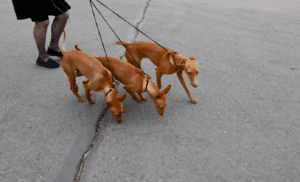
Short hair dogs are more susceptible to UV rays
Seasonal Care Guide for Short-Haired Dogs
Short-haired dogs require specialized seasonal care to maintain optimal health and comfort throughout the changing weather conditions of the year. Their unique coat structure presents specific challenges that demand proactive management as temperatures and environmental conditions fluctuate. Professional groomers recognize that adapting grooming routines to seasonal changes helps prevent common issues while supporting natural coat functions.
Summer Protection Strategies
The minimal insulation of short-haired coats requires careful attention during warmer months to prevent potential health issues related to sun exposure. Short-haired breeds lack the natural protection that longer coats provide against harmful UV rays and elevated temperatures. The distribution of natural oils through regular grooming becomes particularly important during summer months, as these oils help protect the skin from environmental damage.
Winter Weather Adaptations
Short-haired dogs, especially those with single coats, face unique challenges during colder months due to their limited natural insulation. The absence of a dense undercoat means these breeds must rely more heavily on their bodies’ natural temperature regulation systems. Professional groomers emphasize maintaining regular grooming schedules during winter months to support proper oil distribution and skin health.
Managing Continuous Shedding
Unlike long-haired breeds that typically experience heavy seasonal shedding, short-haired dogs shed continuously throughout the year at varying intensities. This ongoing process requires consistent management strategies that adapt to changes in shedding patterns during different seasons. Regular brushing sessions become particularly important during seasonal transitions when shedding patterns might intensify.
Environmental Impact Control
Short-haired dogs experience direct environmental impacts more intensely due to their minimal coat protection against external elements. Changes in humidity levels, exposure to different surfaces, and varying activity patterns all influence coat and skin health throughout the year. Professional care providers recommend adjusting grooming frequency and product selection based on environmental conditions.
Moisture Balance Regulation
Seasonal changes dramatically affect skin moisture levels in short-haired breeds, requiring careful monitoring and adjustment of grooming practices. The relationship between environmental humidity and skin health becomes particularly important during extreme weather conditions. Professional groomers emphasize the importance of adapting conditioning treatments and bathing frequency to maintain optimal moisture balance.
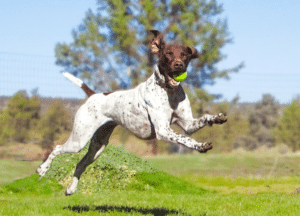
Active short haired dog
Activity Level Adjustments
Changes in seasonal activity patterns affect grooming needs and overall coat health in short-haired breeds. Dogs typically experience variations in exercise intensity and outdoor exposure throughout the year, impacting their grooming requirements. Understanding these seasonal activity changes helps owners adjust their grooming routines to provide optimal care during different times of the year.
Parasite Prevention Focus
Different seasons bring varying risks for parasites and skin conditions that affect short-haired breeds. The minimal protection offered by shorter coats means these dogs might require additional monitoring during peak parasite seasons. Regular grooming sessions provide opportunities to detect and address seasonal pest issues before they become serious problems.
Professional Care Timing
The timing and frequency of professional grooming services often need seasonal adjustment to maintain optimal coat health. Professional groomers provide specialized seasonal treatments that address specific environmental challenges affecting short-haired breeds. These targeted care strategies help prevent common seasonal issues while supporting overall coat health.
Troubleshooting Common Issues with Short-Haired Dogs
The maintenance of short-haired dogs presents unique challenges that require specific solutions to ensure optimal coat health and overall wellbeing. Professional groomers encounter various common issues affecting short-haired breeds that demand targeted intervention strategies. Understanding these challenges and their solutions helps owners maintain their pets’ health while preventing more serious complications from developing.
Managing Excessive Shedding
Year-round shedding represents a significant concern for owners of short-haired breeds, often requiring multiple management approaches. Professional groomers emphasize the importance of establishing consistent brushing routines using appropriate tools designed specifically for short coats. The implementation of proper bathing schedules combined with specialized de-shedding treatments helps control excessive hair loss while maintaining healthy skin conditions.
Addressing Dry Skin Concerns
Short-haired breeds frequently experience dry skin issues due to their limited natural protection against environmental factors. The careful selection of moisturizing products combined with proper grooming techniques helps maintain optimal skin hydration levels. Professional care providers recommend specific conditioning treatments that support natural oil production while preventing excessive dryness.
Resolving Coat Dullness
A lackluster coat often indicates underlying health or maintenance issues that require specific intervention strategies. Professional groomers focus on promoting natural oil distribution through proper brushing techniques and appropriate product selection. The relationship between coat appearance and overall health becomes particularly important when addressing dullness issues in short-haired breeds.
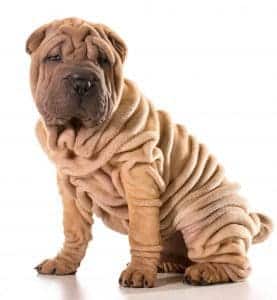
Dog with skin folds
Treating Skin Fold Irritation
Dogs with facial wrinkles or skin folds require extra attention to prevent common irritation issues. Professional care focuses on maintaining proper cleanliness and dryness within skin folds to prevent bacterial or fungal growth. Regular cleaning with appropriate products helps prevent inflammation while maintaining healthy skin conditions in these sensitive areas.
Correcting Uneven Shedding
Irregular shedding patterns often develop in short-haired breeds, creating patches of different coat densities or textures. Professional groomers address these issues through targeted brushing techniques and specialized grooming tools designed for short coats. The implementation of consistent grooming routines helps prevent uneven shedding while maintaining uniform coat appearance.
Addressing Oil Buildup
Excessive oil accumulation can create various issues for short-haired breeds, including skin problems and unpleasant odors. Professional care providers emphasize the importance of proper bathing frequency and appropriate product selection to maintain optimal oil balance. Regular monitoring helps prevent oil buildup while ensuring adequate moisture levels for healthy skin and coat.
Managing Temperature Sensitivity
Short-haired breeds often show increased sensitivity to temperature changes due to their limited natural insulation. Professional groomers recommend specific care strategies that help dogs maintain proper body temperature regulation throughout various weather conditions. Understanding these sensitivities helps owners provide appropriate protection while maintaining regular grooming routines.
Identifying Health Indicators
Regular grooming sessions provide opportunities to detect early warning signs of potential health issues affecting short-haired breeds. Professional care providers emphasize the importance of monitoring changes in coat texture, skin condition, and overall appearance. The early identification of these indicators enables prompt intervention before conditions become more serious.
Let’s face it – your short-haired pup is more than just a pet; they’re family. And just like any family member, they deserve the best care possible. While their grooming needs might seem simpler than their fluffy counterparts, maintaining their coat health is crucial for their overall wellbeing and comfort.
Ready to give your short-haired dog the care they deserve? Banixx’s specially formulated products provide the perfect solution for maintaining your dog’s coat health. Our gentle, non-antibiotic formulas work with your dog’s natural skin chemistry to promote a healthy, shiny coat while preventing common skin issues.
Whether you’re dealing with dry skin, excessive shedding, or just want to maintain that beautiful shine, Banixx has you covered. Try our proven pet care products today and see the difference proper short-hair care can make!
Learn More from Banixx Pet Care
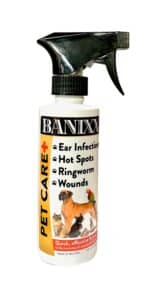
Banixx Pet Spray
At Banixx, we’re committed to helping you keep your dog in top health. Our website offers a wealth of resources on preventive care, treatment options, and everyday tips for dog wellness.
Whether you’re dealing withparasites, pondering the best dietary choices, or looking for ways to enhance your dog’s life, Banixx is here to support you every step of the way.
We invite you to join us on this journey, via our dogblog, ensuring that every wag, woof, and playful leap is filled with health and happiness. We have a variety of other blog topics to please everyone, such aswhy your dog sleeps against you, orif dogs can get psoriasissyep, we’ve got those covered.
Sources
https://www.parkroadvet.com/blog/february-2022/skin-cancer-advice-for-short-hair-dogs
https://www.purina.com/dogs/dog-breeds/collections/short-haired-dog-breeds
https://wagwalking.com/grooming/groom-a-short-haired-dog
https://www.animalbehaviorcollege.com/blog/animal-career-advice/grooming/5-grooming-tips-for-shorthaired-dogs/



